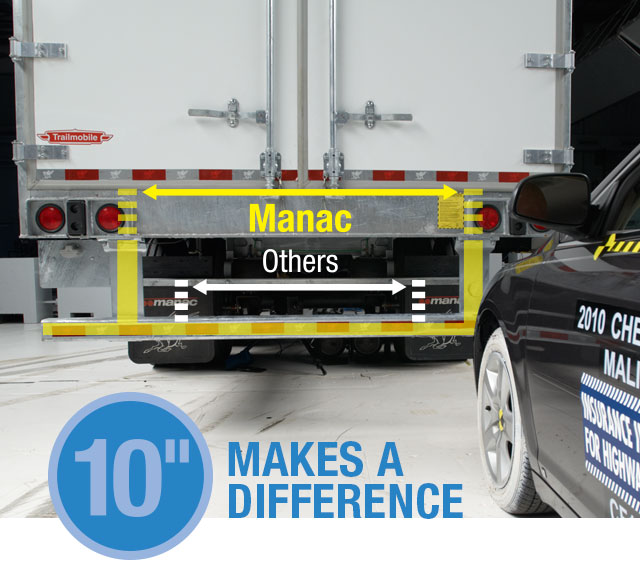Underride guards can be lifesavers, but most could be improved
March 14, 2013

Modern semitrailers for the most part do a good job of keeping passenger vehicles from sliding underneath them, greatly increasing the chances of surviving a crash into the back of a large truck, recent IIHS crash tests show. But in crashes involving only a small portion of the truck's rear, most trailers fail to prevent potentially deadly underride.
Most semitrailers are required to have underride guards. These are steel bars that hang from the backs of trailers to prevent the front of a passenger vehicle from moving underneath during a crash. Earlier research showed the minimum strength and dimensions required for underride guards in the U.S. are inadequate, prompting IIHS to petition the National Highway Traffic Safety Administration (NHTSA) in 2011 for tougher standards. The Institute also asked the agency to consider applying the standards to other large trucks such as dump trucks that aren't required to have any underride guards.
Although NHTSA hasn't responded yet, trailer manufacturers already are installing guards that are much stronger than required. These guards generally work well to prevent underride, except in crashes occurring at the outer edges of trailers, the crash tests show.
One likely reason manufacturers are installing guards that are stronger than required is a tougher standard that trailers in Canada have had to meet since 2007. More recently, IIHS crash tests have drawn attention to the issue, and at least one manufacturer has started selling a trailer with an improved underride guard since the tests began.
To see how well the latest guards work, IIHS engineers put trailers from the eight largest manufacturers through a series of progressively tougher crash tests. These manufacturers made about 80 percent of heavy trailers produced in North America in 2011. All the trailers had underride guards that met both U.S. and Canadian standards. Both standards require the guard to withstand a certain amount of force at various points. Under the Canadian regulation, a guard must withstand about twice as much force as required by the U.S. rule at the point where it attaches to its vertical support.
In each crash test, a 2010 Chevrolet Malibu struck a parked truck at 35 mph. In the first scenario, the car was aimed at the center of the trailer. All eight guards successfully prevented underride, including one from Hyundai Translead, whose earlier model failed a full-width test by IIHS. In the second test, in which only half the width of the car overlapped with the trailer, all but one trailer passed. However, when the overlap was reduced to 30 percent, every trailer except one from the Canadian manufacturer Manac failed. Manac sells dry van trailers in the U.S. under the name Trailmobile. The Institute uses a 30 percent overlap for the most challenging underride test because it is the minimum overlap under which a passenger vehicle occupant's head is likely to strike a trailer if an underride guard fails.
"Our tests suggest that meeting the stronger Canadian standard is a good first step, but Manac shows it's possible to go much further," says David Zuby, the Institute's chief research officer.
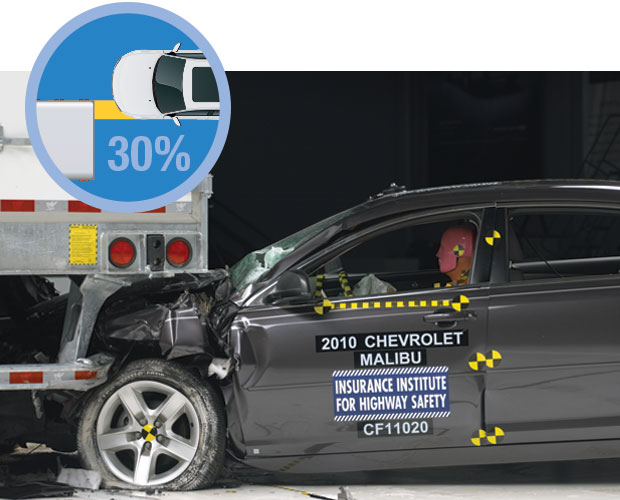
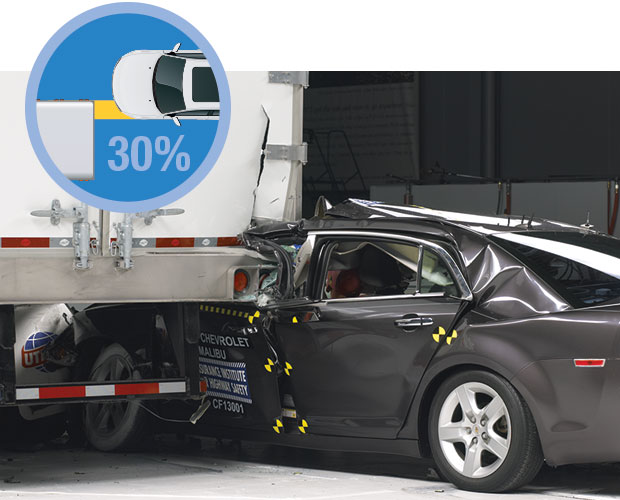
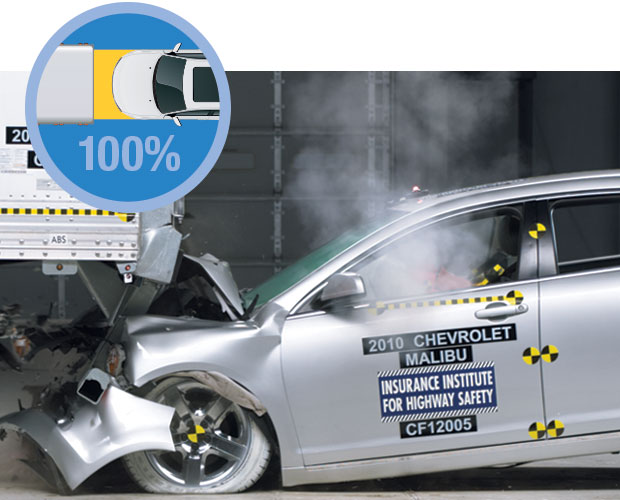
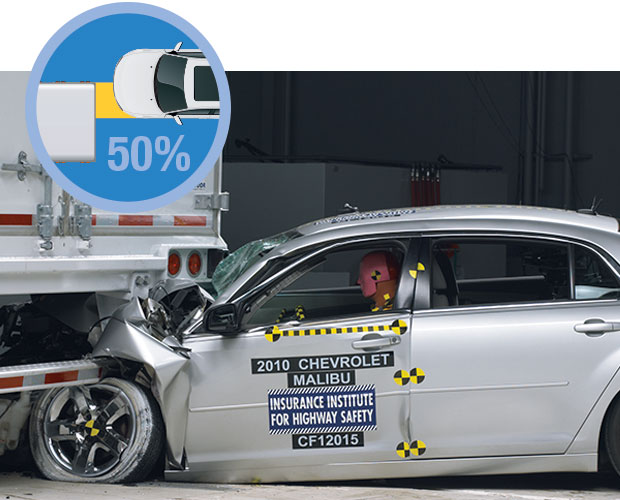
The danger of underride
All the improvements in occupant protection that have helped drive down crash deaths in recent decades count for little when the front of a passenger vehicle ends up under a truck. When this happens, the top of the occupant compartment gets crushed because the vehicle structures designed to absorb crash energy are bypassed. Airbags and safety belts can't do their jobs, and people inside the vehicle can experience life-threatening head and neck injuries.
The crash tests show how this occurs. The 2010 Malibu was an IIHS Top Safety Pick, and in the 40 mph moderate overlap barrier test used to evaluate the car's frontal crashworthiness, measurements recorded by a dummy in the driver seat indicated serious injuries were unlikely. Similarly, in the underride tests in which the guards held up, the Malibu's structure and airbags protected the dummy, and injury measures were generally low and not life-threatening. In contrast, when the guards failed, head and neck injury measures were so high that real drivers would have died.
In 2011, 260 of the 2,241 passenger vehicle occupants killed in large truck crashes died when the fronts of their vehicles struck the rears of trucks. That's down from 460 out of 3,693 in 2004. The decline is likely due in part to changes in traffic amid the weak economy.
Gaps in federal data make it difficult to pinpoint how many crashes involve underride. A 2011 IIHS study of 115 crashes in which a passenger vehicle struck the back of a heavy truck or semitrailer found only about one-fifth involved no underride or negligible underride. Nearly half of the vehicles had severe or catastrophic underride damage, and they accounted for 23 of the 28 fatal crashes in the study. More than half the trucks weren't required to have underride guards.
Crash test results
The Institute previously released the results of an initial round of crash testing on three semitrailers conducted in 2010 and 2011. The weakest guard tested at that time was from Hyundai. It met the U.S. standard for strength but not the Canadian one. When the Malibu hit the center of the trailer in a full-width crash, the guard broke, resulting in catastrophic underride. In 50 percent overlap tests, the underride guard on a Vanguard trailer allowed moderate underride at 25 mph and severe underride at 35 mph.
In contrast, a Wabash trailer had no underride in either the full-width or the 50 percent overlap test. However, when it was put through the 30 percent overlap test, the underride was catastrophic. That's because the car hit the guard outside its vertical attachment bar, causing the unsupported end to bend forward. The Wabash underride guard hasn't been redesigned since then.
"This weakness at the ends is the same problem we saw in all the trailers that passed the 50 percent overlap but failed the 30 percent over the course of our testing," says Matthew Brumbelow, an IIHS senior research engineer.
Since the initial evaluations, IIHS tested Hyundai and Vanguard trailers again after the companies made changes to their underride guards. Trailers from five more companies also were tested. All eight manufacturers now have underride guards meeting the Canadian standard, and none of the current designs had any difficulty passing the full-width test. Most passed the 50 percent overlap test, too. The exception was the Vanguard. The guard's vertical support broke off the trailer when the guard was hit by the car, just as it did in the test of the previous design.
"Vanguard's older and newer underride guards were certified to the Canadian standard, so clearly the Canadian regulation, while an improvement over the U.S. rule, isn't stringent enough," Zuby says. "Failing the 50 percent test is a big problem because in our analysis of real-world crashes with the rears of trucks, about half of those with severe underride had overlaps of 50 percent or less."
A better design
Although the rest of the trailers passed the 50 percent overlap test, most failed the 30 percent. The problem stems from the location of the underride guards' vertical supports. On most trailers, the supports are attached to the slider rails, which run lengthwise under the trailer and allow the position of the wheels to be changed depending on the load. Using this structure as the underride guard's attachment point means the vertical supports are located an average of 28 inches from the trailer's edge.
Manac, the only trailer to pass the 30 percent test, takes a different approach. The company's engineers realized the supports should be spread further apart to transfer more strength from the center to the outer ends of the guard, says Manac President Charles Dutil. They decided to attach the supports to a reinforced floor and spaced them just 18 inches from the edge. The result is a better design but not a huge additional cost, he says.
The Manac underride guard "doesn't weigh 200 pounds more than anybody else's; it doesn't cost $200 more," Dutil says, estimating the difference to be at most 20 pounds and $20. The design of the mounting not only does a better job preventing underride but also minimizes damage to the trailer itself in rear crashes, he notes.
That held true in the IIHS crash tests. The Manac trailer had damage estimates that were among the lowest of all the trailers, requiring only a replacement underride guard.
"If trailer manufacturers can make guards that do a better job of protecting passenger vehicle occupants while also promising lower repair costs for their customers, that's a win-win," Zuby says. "While we're counting on NHTSA to come up with a more effective regulation, we hope that in the meantime trailer buyers take note of our findings and insist on stronger guards."
